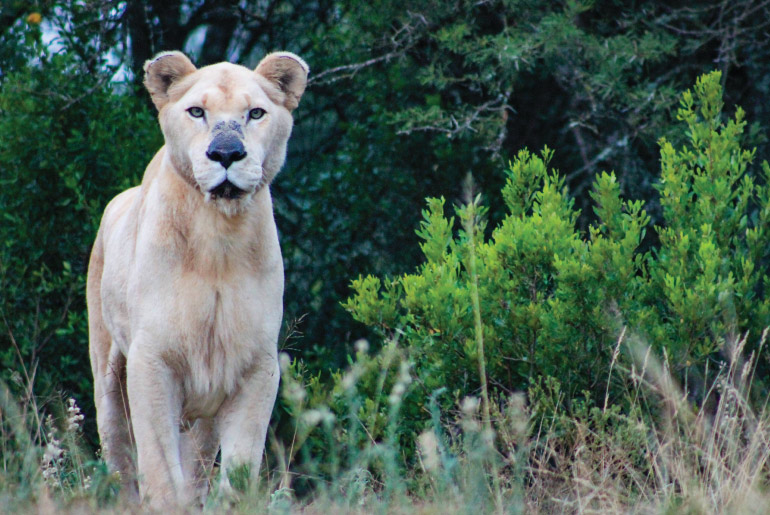

UND grad opens South African sanctuary that’s home to 14 lions and a tiger.
Lily is a 20-year-old lioness who lives at the Simbonga Game Reserve and Sanctuary in South Africa.
The view from Lily’s enclosure is straight out of a National Geographic film. Giraffes
and zebras saunter by; herds of wildebeests, waterbucks, antelopes and impalas gallop
across the grassy terrain; a variety of birds flies overhead, and occasionally a monkey
climbs into Lily’s space.
But life wasn’t always picture-perfect for Lily. UND grad Lauren (Vad) Smith, ’13,
co-manager of Simbonga, recalls the operation to save Lily’s life.
Lily was rescued from a South African predator park that was shut down after a handler fatality, Lauren said. The younger animals were quickly rehomed, but because of Lily’s age, 19 at that time, it was risky to transport her. The life expectancy of lions in captivity is 20.
The staff at Simbonga welcomed Lily, saving her from euthanasia. But shortly after arriving, Lily got very sick and tests showed she was vitamin B12 deficient. “B12 comes from red meat. A lion should never be lacking it,” Lauren said.
A vet determined that someone at the park Lily was rescued from had fed her rotten meat, which impaired her neurological functioning.
At her sickest, Lily allowed Lauren to hand-feed her. “This big, huge, bold, very
independent lioness allowed me to work with her in that capacity after years of neglect.
That was it for me.”
While Lauren said picking a favorite animal at Simbonga is like picking a favorite
child, she admitted that “Lily has a special place in my heart; she is the apple of
my eye.”
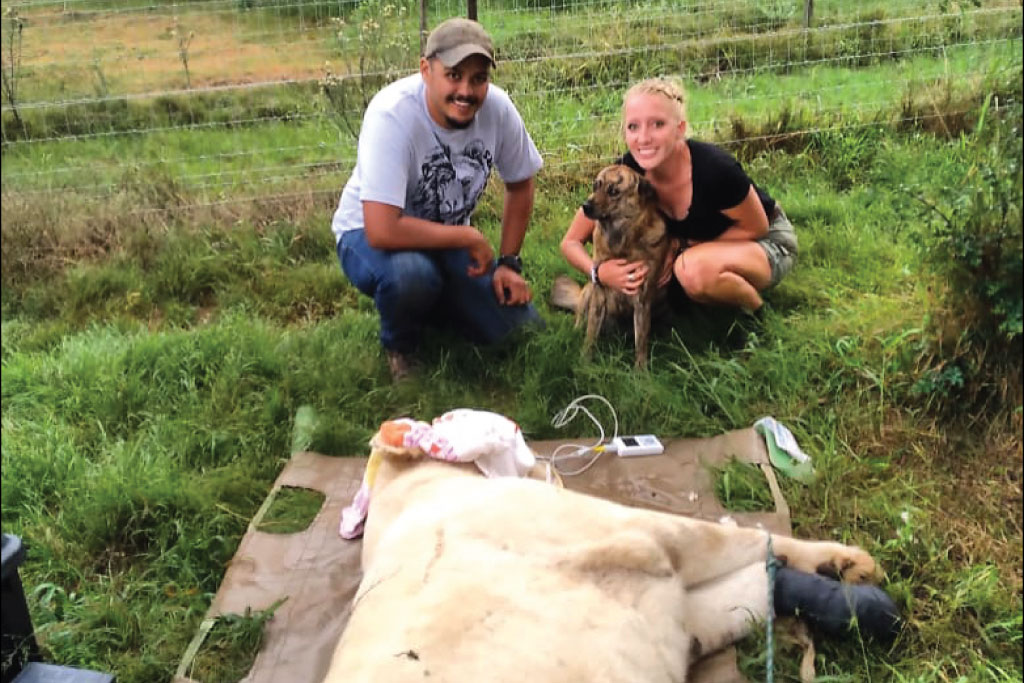
Lauren, her husband, Keegan, and her dog are all part of Lily's team.
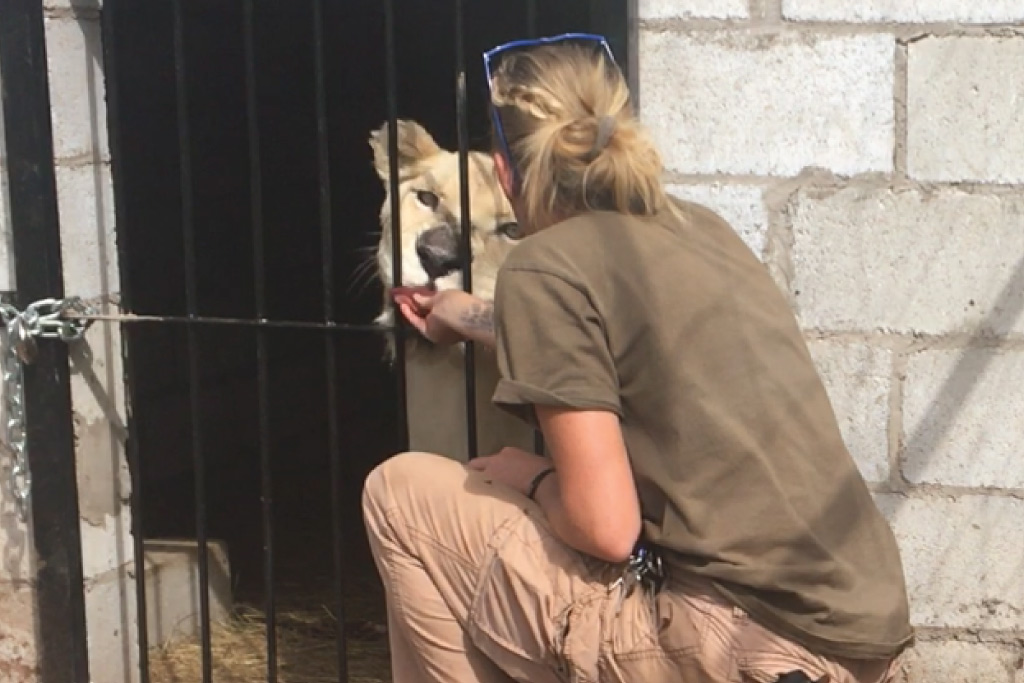
Lily's health improves with lots of care from Lauren.
Originally from Bottineau, North Dakota, Lauren completed her education degree at UND in 2013 and thought teaching children would be her vocation. After college, she took a volunteer trip to a South African animal rescue. She expected to stay three to six months, but her ability to lead educational tours led to an internship working with lions and tigers. That’s when she veered in another direction.
“I’ve always had a passion to help. Other than kids, I love animals, especially those in need. I ended up at a volunteer project that had a lot of big cats.”
Lauren learned about the challenges lions and tigers face in captivity. Wildlife trafficking ranks as the world’s third-largest illegal trade; U.S. Customs and Border Protection says smuggled goods are valued at $10 billion annually. Traffickers exploit wildlife and their products for purposes ranging from medicine and fashion to food and pets.
South Africa’s wildlife industry often exploits lions, native to the area. “Many people see dollar signs when they look at the animals,” Lauren said. “Hunters pay to come over and shoot these completely captive hand-raised animals; they become a trophy on one’s wall.”
Lauren said lions are bred in zoos or used in circuses, calling them high-priced photo opportunities for tourists. Their bones are illegally traded, sometimes used in medicinal products.
“These animals are used like toys. And when they get too big, they are released into the wild and killed because no one wants to look after them anymore.”
After spending time in captivity, lions are unfit to be released back into the wild. After learning that, Lauren realized she could be their advocate. “I was someone who would speak up for these animals.”
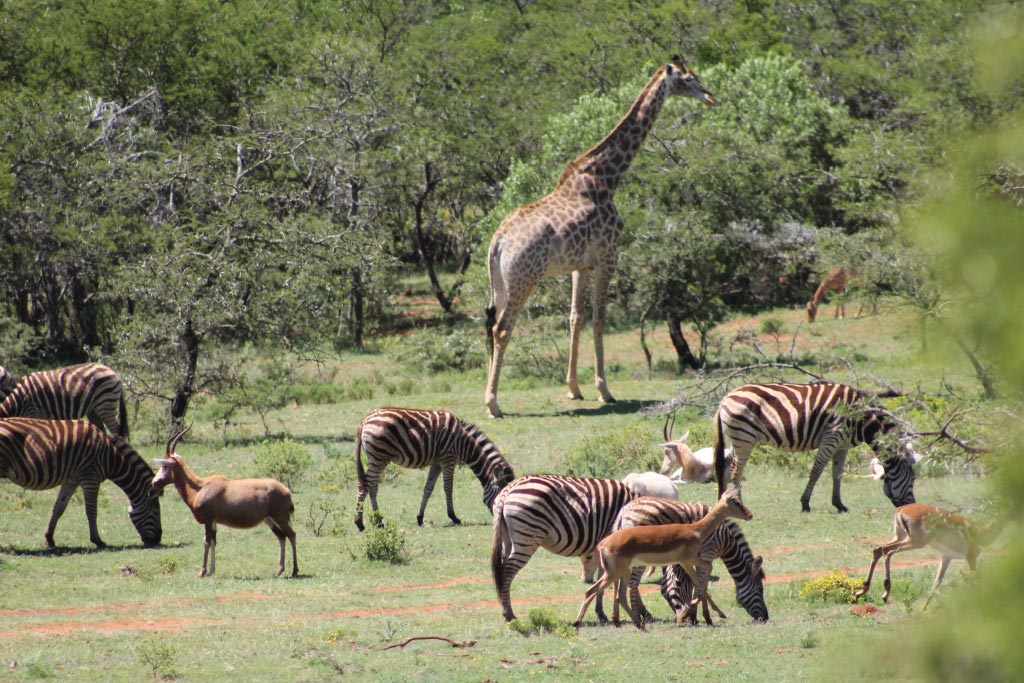
A variety of animals roam the reserve.
As her love for lions grew, she met her eventual husband and Simbonga Sanctuary co-manager, Keegan Smith, who she said is equally compassionate.
Lauren and Keegan connected with Lionel de Lange, founder and director of Warriors of Wildlife (WoW), who helped them establish a sanctuary.
“We wanted to ensure we were rescuing these animals for their future,” Lauren said. “WoW’s goal is to bring the rescued animals to the most species-appropriate place.”
For lions, native to South Africa, the Simbonga Sanctuary and Reserve is ideal.
It’s hard to get house sitters when you have big cats.Lauren (Vad) Smith, ’13
Sanctuary construction began in January 2021, and on April 28, Simbonga took in its first four lions from Ukraine. That first rescue, Lauren said, was an “emotional roller coaster” as the team of three worked to prepare the sanctuary.
They secured accreditation to handle abused and neglected animals. Then, they tackled the logistical work of constructing and organizing Simbonga.
Meanwhile, the trio needed to secure a strong network of wildlife advocates from around the globe. “Every country, state and province has its own set of regulations concerning wildlife, and they often change,” Lauren said. “Since it is nearly impossible to know all of them, we rely on local experts.”
Lionel, with previous experience in Ukraine, spearheaded the first rescue. “We needed to move quickly because the more time we took, the longer the animals had to wait and more harm could be done,” Lauren said.
Simbonga welcomed two females who had been sold as pets in Ukraine and two males who had lived their entire lives in a zoo. Three of the four first arrivals had never experienced the feel of grass or even soil beneath their paws.
“That rescue solidified everything. It was the most impactful because it was the first,” Lauren said. “As much as it was exciting, it was also a relief. So much went into it. I cried for two weeks straight afterward. I kept pinching myself: ‘We did it!’ I’d wake up in the night and go check on them.”
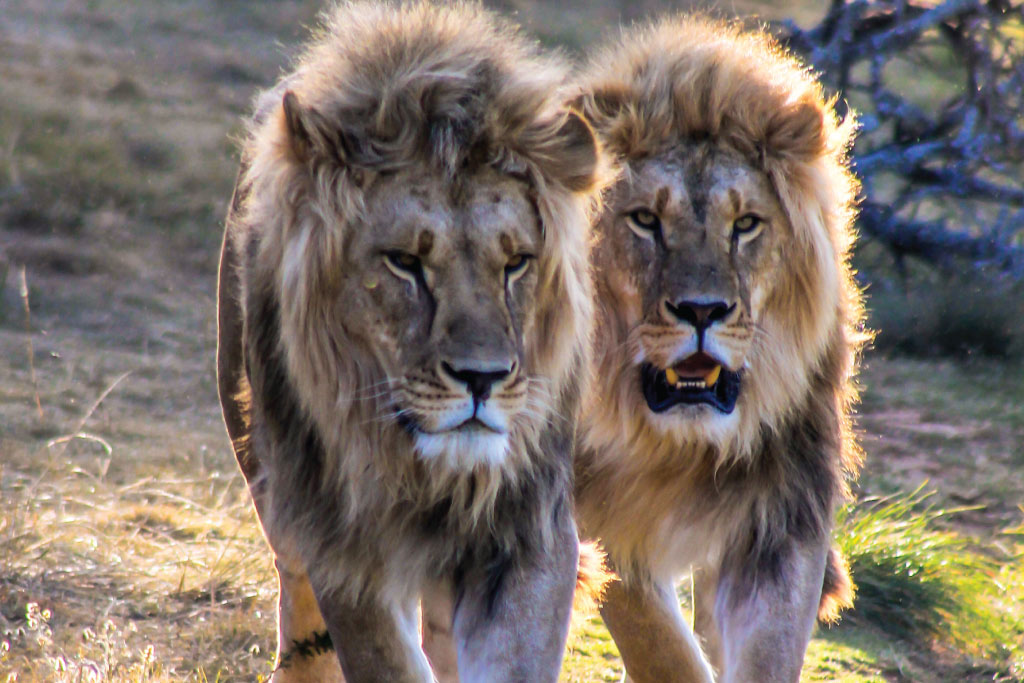
Caesar and Alex roam the sanctuary.
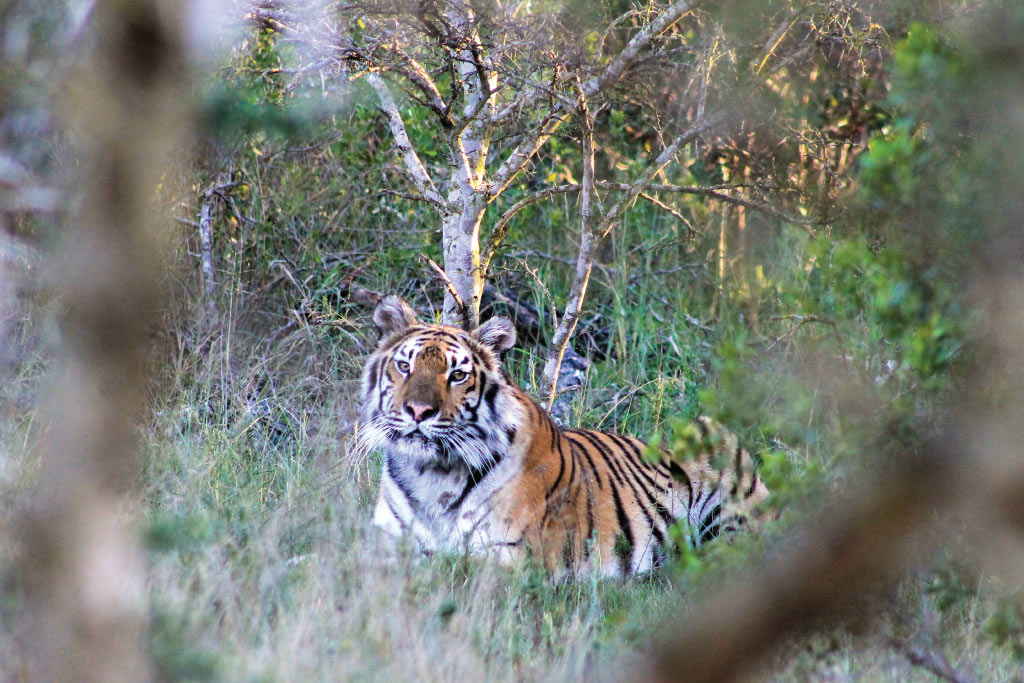
One tiger calls the Reserve home.
Two years later, in mid-May 2023, the sanctuary prepared for its first Israeli rescue. The team planned to transport a lion cub named Zion, who had been illegally smuggled into the country. After a few TikTok videos showing the cub in an apartment went viral, Israeli police and Israeli Nature Authority agents tracked and rescued the cub. A mutual Israeli acquaintance suggested Simbonga as its home. This is typical; Lauren said the WoW team learns of potential rescues by word of mouth 90% of the time.
Israel has a strong and communicative Nature and Parks Authority, so Lauren was confident the cub would be well cared for. Though their plan seemed airtight, Lauren said anything can happen. And in this case, something did.
“We’re flying Saturday,” Lauren said on Wednesday of the same week. “The airline we booked for the domestic connection transports large-breed dogs and was confident our crate would fit. Today, I got a call that the flight is no longer available. It was quite a nightmare. And an example of the problem-solving we do to get these animals to safety.”
Lauren was able to secure an alternate flight, but it increased Zion’s travel time
by eight hours. “We try to make the animal journeys as short as possible to keep them
comfortable.”
Keegan met the cub at the Johannesburg airport, while Lauren stayed at the sanctuary
to care for the animals. “It’s hard to get house sitters when you have big cats,”
she said.
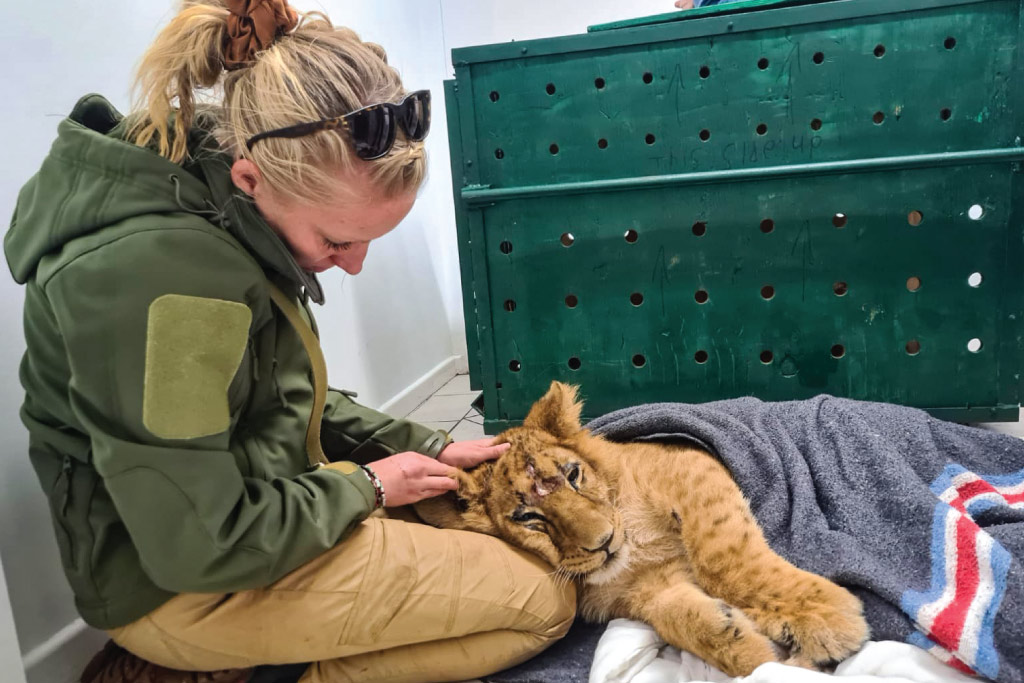
Lauren comforts Zion after his arrival.
Lauren and Keegan manage the sanctuary and provide lifelong care. Every morning and evening, they check on the animals. “It’s very much like waking up and taking your dog out,” Lauren said.
They feed the lions red meat two or three times a week, which mimics wild habits. They also conduct enrichment activities to engage the lions’ senses and keep them mentally stimulated.
Because the sanctuary is located on a game reserve, Lauren and Keegan monitor the free-roaming animals and do regular maintenance, like fixing fences. “It’s like being on a farm; it’s just lions instead of cows, so we have a slightly different safety protocol,” Lauren laughed.
Topping the list of Simbonga safety rules is no hands-on interaction with the animals. “A lion will always be a wild animal. We don’t want to get complacent and forget exactly what these animals are designed to do and who they are,” Lauren said. For example, the lion enclosures are open at the top and occasionally, the lions get visitors, like monkeys. “If a monkey gets in, it is fair game to be hunted.”
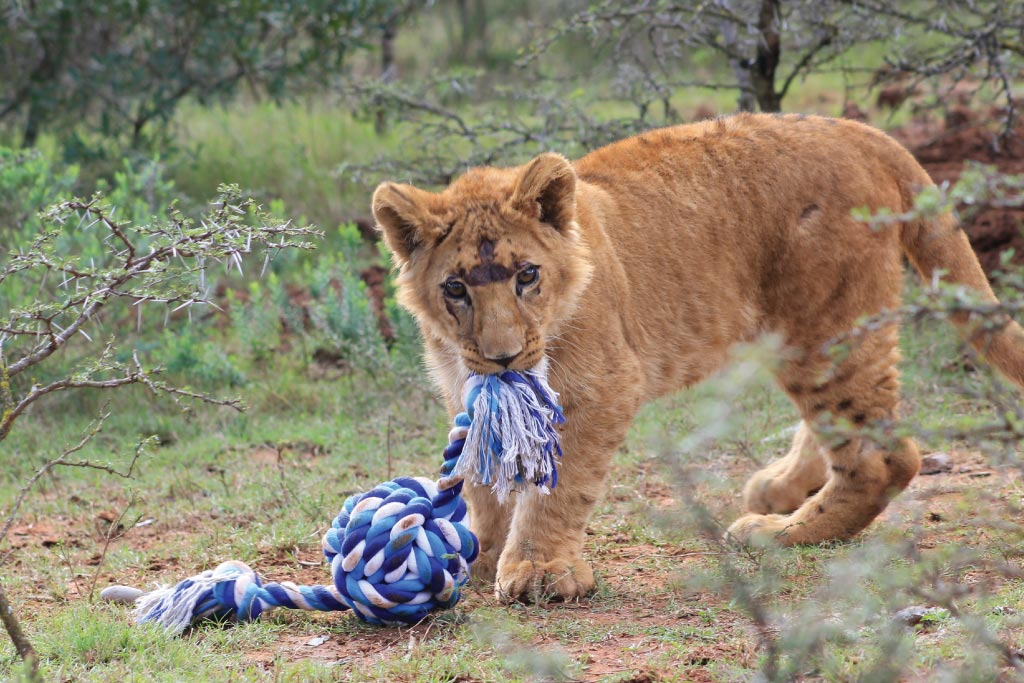
Zion quickly adapts to his new home.
Lauren is often asked how to pursue a job like hers. “I’m not the best person to ask because I didn’t do an animal-based degree. Life just kind of steered me in this direction.”
Though not in the ways she expected, Lauren leans on her UND teaching degree – for instance, she still provides educational information and tours to guests and volunteers.
“Many of my professors at UND were so good at teaching how to be in the world. They taught us to think on our feet and be prepared because we’re working with living beings. As much as I’m not in a classroom, I’m using the skills – collaboration, teamwork, and networking – that were reinforced in every class I took.”
While teachers generally get summers off, not so for Lauren. “Days off don’t exist. When we started the sanctuary, we very much knew we were starting a lifelong project.”
The project means a rather primitive living environment. Lauren and Keegan essentially live in a tent, which means that uninvited guests sometimes drop by. Earlier that day, she said, a venomous snake had dropped from the ceiling. The couple captured it with a bucket lid.
“If you live amongst the animals, you live amongst them all,” Lauren said.
And while that includes an occasional visit from a poisonous reptile, it also includes 15 big cats – 13 adult lions, one lion cub and one tiger – who are like family.